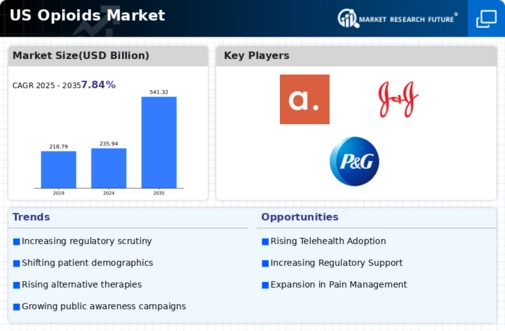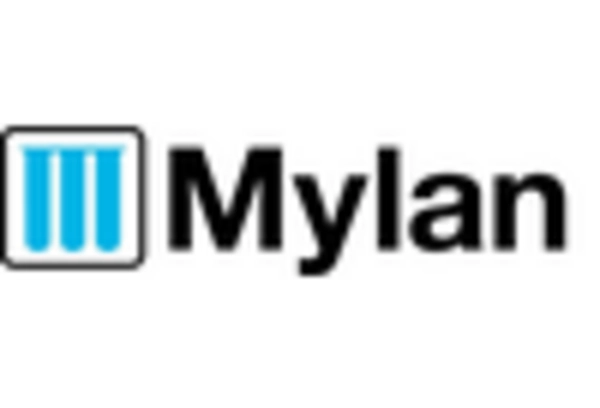Rising Pain Management Needs
The increasing prevalence of chronic pain conditions in the US is a primary driver for the opioids market. According to recent data, approximately 20% of adults in the US experience chronic pain, leading to a heightened demand for effective pain management solutions. This trend is likely to continue as the aging population grows, with projections indicating that by 2030, nearly 20% of the US population will be over 65 years old. As healthcare providers seek to address these needs, the opioids market is expected to expand, with a focus on balancing efficacy and safety in pain management. The ongoing evolution of treatment protocols may further influence prescribing practices, thereby impacting market dynamics.
Evolving Regulatory Landscape
The regulatory environment surrounding the opioids market is undergoing significant changes, which could have profound implications for market dynamics. Recent legislative efforts aim to address the opioid crisis by implementing stricter prescribing guidelines and enhancing monitoring systems. For instance, the introduction of prescription drug monitoring programs (PDMPs) has been shown to reduce opioid prescriptions by approximately 10-15% in states that have adopted them. These regulations may lead to a shift in prescribing patterns, with healthcare providers increasingly opting for alternative pain management therapies. While these measures are intended to curb misuse, they may also create challenges for patients requiring legitimate pain relief, thereby influencing the overall market landscape.
Increased Focus on Addiction Treatment
The growing recognition of opioid addiction as a public health crisis is driving demand for comprehensive treatment options within the opioids market. With an estimated 2 million individuals in the US suffering from opioid use disorder, there is an urgent need for effective addiction treatment programs. This has led to increased funding for rehabilitation services and the development of medications aimed at treating addiction, such as buprenorphine and methadone. As healthcare systems prioritize addiction treatment, the market may see a shift in focus from solely pain management to a more holistic approach that includes addiction recovery. This dual focus could reshape the landscape of the opioids market, influencing both prescribing practices and patient outcomes.
Growing Demand for Personalized Medicine
The trend towards personalized medicine is emerging as a key driver in the opioids market. As healthcare providers increasingly recognize that patients respond differently to medications, there is a growing emphasis on tailoring pain management strategies to individual needs. Genetic testing and biomarker identification are becoming more prevalent, allowing for more precise prescribing of opioids and alternative therapies. This shift towards personalized approaches may enhance treatment efficacy and minimize the risk of adverse effects. As the healthcare industry continues to evolve, the opioids market is likely to adapt to these changes, potentially leading to more effective pain management solutions that align with the principles of personalized medicine.
Advancements in Pain Management Technologies
Technological innovations in pain management are emerging as a significant driver for the opioids market. The development of new drug delivery systems, such as transdermal patches and implantable devices, offers potential alternatives to traditional oral opioids. These advancements may enhance patient compliance and reduce the risk of misuse. Furthermore, the integration of digital health technologies, including telemedicine and mobile health applications, is facilitating better patient monitoring and management of pain conditions. As these technologies gain traction, they could reshape the treatment landscape, potentially impacting the demand for traditional opioids. The opioids market may thus experience a transformation as healthcare providers adopt these innovative solutions.

















Leave a Comment